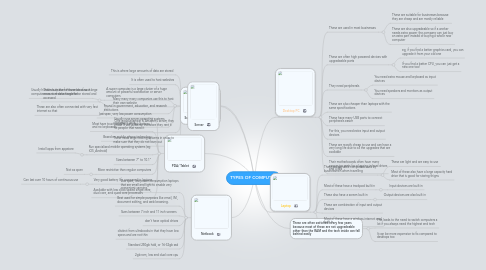
1. PDA/ Tablet
1.1. low spec, very low power consumption
1.2. Most have touch screens, very few buttons, and no keyboards
1.3. Based on mobile phone technology
1.4. Run specialized mobile operating systems (eg iOS, Android)
1.4.1. Install apps from appstore
1.5. Sizes between 7" to 10.1"
1.6. More restrictive than regular computers
1.6.1. Not as open
1.7. Very good battery life compared to laptops
1.7.1. Can last over 10 hours of continuous use
1.8. Available with low clock speed single core, dual core, and quad core processors
2. Netbook
2.1. Low spec, low power consumption laptops that are small and light to enable very convenient carrying.
2.2. Best used for simple purposes like email, IM, document editing, and web browsing.
2.3. Sizes between 7 inch and 11 inch screens
2.4. don't have optical drives
2.5. distinct from ultrabooks in that they have low specs and are not thin
2.6. Standard 250gb hdd, or 16-32gb ssd
2.7. 2gb ram, low end dual core cpu
3. Super Computer
3.1. A super computer is a large cluster of a huge amount of powerful workstation or server computers
3.1.1. Usually hundreds or even thousands of such computers are connected together
3.2. Found in government, education, and research institutions
3.3. Usually runs server operating systems, commonly linux
4. Server
4.1. This is where large amounts of data are stored
4.2. It is often used to host websites
4.3. Many many many companies use this to host their own website
4.3.1. This is suitable for them because a large amount of data needs to be stored and accessed
4.3.2. These are also often connected with very fast internet so that
4.4. One good example is Amazon's server, they made it too powerful therefore they rent it to people that need it
4.5. These need large cooling systems in order to make sure that they do not burn out
5. These are often switched every few years because most of these are not upgradeable other than the RAM and the tech inside can fall behind easily
5.1. This leads to the need to switch computers a lot if you always need the highest end tech
5.2. It can be more expensive to fix compared to desktops too
6. Desktop PC
6.1. These are used in most businesses
6.1.1. These are suitable for businesses because they are cheap and are mostly reliable
6.1.2. These are also upgradeable so if a worker needs extra power, the company can just buy an extra part instead of buying a whole new computer
6.2. These are often high powered devices with upgradeable parts
6.2.1. eg, if you find a better graphics card, you can upgrade it from your old one
6.2.2. If you find a better CPU, you can just get a new one too!
6.3. They need peripherals
6.3.1. You need extra mouse and keyboard as input devices
6.3.2. You need speakers and monitors as output devices
6.4. These are also cheaper than laptops with the same specifications
6.5. These have many USB ports to connect peripherals easier
6.6. For this, you need extra input and output devices
6.7. These are mostly cheap to use and can have a very long life due to all the upgrades that are available
6.8. Their motherboards often have many expansion ports for plugging in hard drives and USBs
7. Laptop
7.1. These are portable computers used by businessmen when travelling
7.1.1. These are light and are easy to use
7.1.2. Most of these also have a large capacity hard drive that is good for storing thigns
7.2. Most of these have a trackpad built in
7.2.1. Input devices are built in
7.3. These also have a screen built in
7.3.1. Output devices are also built in
